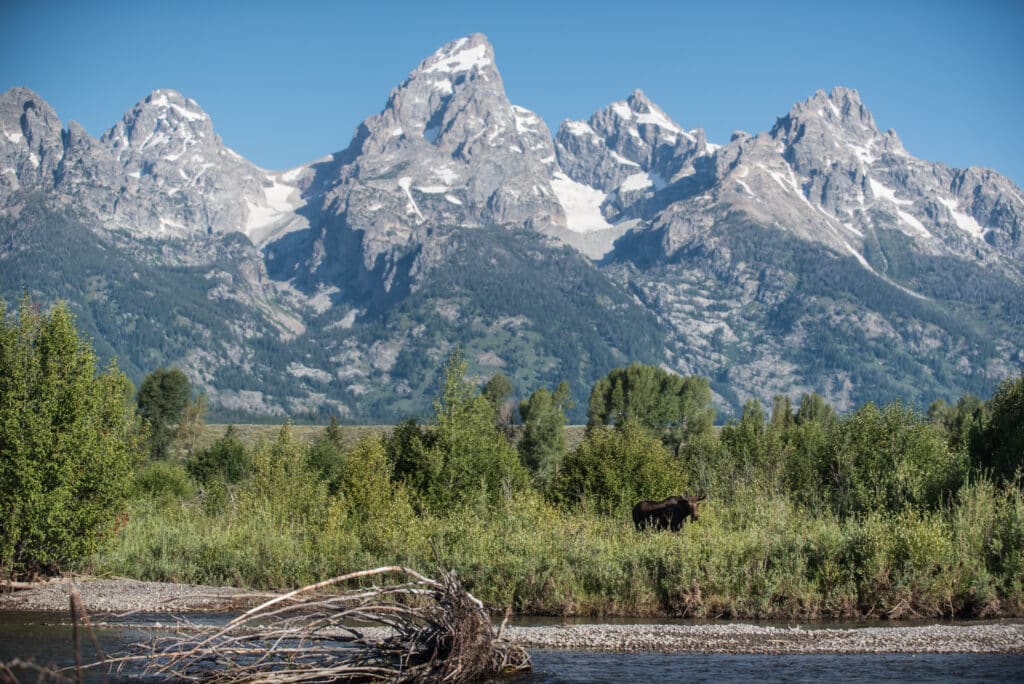The Riparian Zone: Secrets of the Grand Teton Moose

Imagine this: Majestic antlers pierce the twilight sky, a powerful silhouette looms against the backdrop of the Tetons – the moose is an emblem of Grand Teton National Park. But for Barker Ewing Scenic Float Trips, a moose sighting is more than just a photo op; it’s a chance to witness a fascinating creature in its natural splendor.
This summer, accompany our experienced guides on a scenic Snake River float trip, and keep your eyes peeled for one of these gentle giants. But before your adventure, let’s delve into the secret lives of the Grand Teton moose, drawing insights from the National Park Service.
Fueling Up on Nature’s Bounty
Moose are herbivores, with a particular fondness for aquatic plants. During the summer months, they graze on willows, pondweeds, and water lilies found in the park’s wetlands and riverbanks. You might even spot them wading into the shallows for a midday snack, and we have seen them swim the fastest currents on the Snake River to find food on neighboring islands.
Finding Rest in Unexpected Places
While moose may seem imposing, they actually spend a significant portion of their day snoozing. They favor dense willow thickets or sheltered areas in forests for daytime naps. At night, they might venture out to open meadows to graze under the cover of darkness. Visitors can also find Moose along some of the hiking trails in the many deep alpine canyons in the Teton Range.
Winter Wonderland Woes
As the snow falls and temperatures plummet, the Jackson Hole landscape transforms. While the Tetons shimmer in a blanket of white, life for moose becomes a bit more challenging. The moose have a snow adaptability of 10 on a scale of 0 to 10, (due to their big size, heavy dark coats, and long legs) but still, deep snow makes it difficult to access their preferred food sources. To conserve energy, they enter a state of partial dormancy, relying on fat reserves built up during the summer months. Their heavy winter coats help them conserve heat energy. Sometimes they can be found in dense Douglas Fir stands hiding under the branches where they are insulated from the cold winter winds. They also break through the snow to munch on twigs and bark from trees.
Witnessing the Magic Firsthand
While spotting a moose in the wild is never guaranteed, Barker Ewing Scenic Float Trips takes you through some prime moose habitat. Our experienced guides will share their knowledge of moose behavior and point out signs of their presence, like tracks or feeding areas.
A Responsible Encounter
Remember, moose are wild animals and are unpredictable. It’s crucial to maintain a safe distance (at least 50 yards) and avoid approaching them on trails. Talk with your hiking partners as you travel so the moose can hear you coming and thus avoid surprise encounters. By respecting their space, you can help ensure an unforgettable wildlife encounter for yourself and protect these magnificent creatures.
So, are you ready to embark on a journey of discovery? Join Barker Ewing Scenic Float Trips and explore the Snake River in Grand Teton National Park. You might just find yourself face-to-face with a majestic moose, and create memories that will last a lifetime.
Sources:
National Park Service. (n.d.). Moose in Grand Teton and Yellowstone National Parks. https://www.nps.gov/grte/planyourvisit/basicinfo.htm
Muehlenberg, M. S. (1980). Habitat use by female moose in northern Yellowstone National Park. Journal of Wildlife Management, 44(4), 875-884.
Schmidt, K. M., Bergstrom, B. J., & Jenks, J. A. (2014). Influences of climate and density on survival and cause-specific mortality of female moose in Grand Teton National Park. Journal of Mammalogy, 95(2), 363-374.
